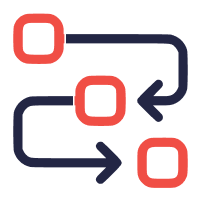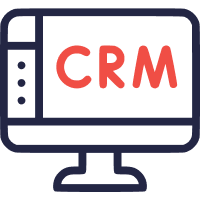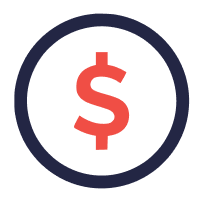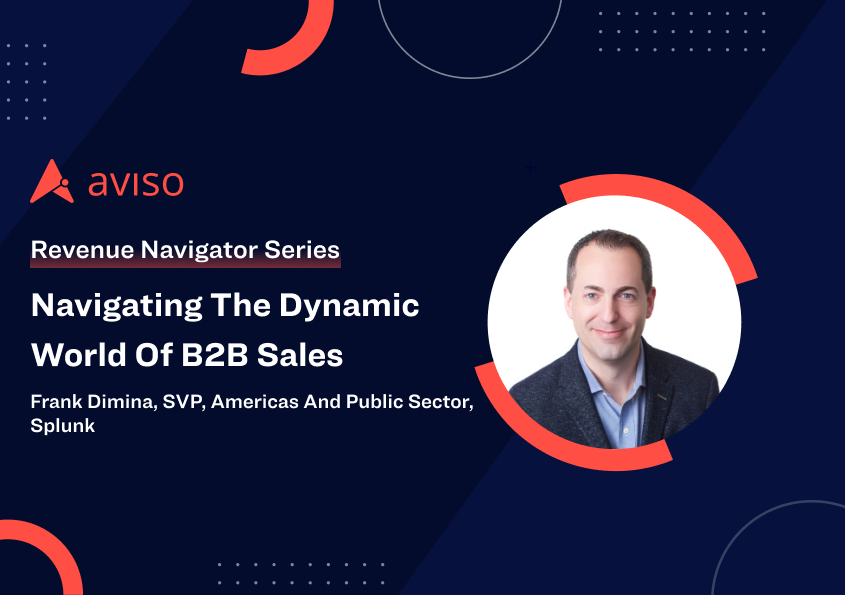Frank Dimina, SVP, Americas and Public Sector at Splunk
As part of Aviso's Revenue Navigators Series, we spoke with Frank Dimina, SVP, Americas and Public Sector at Splunk. With over 20 years of experience leading technology organizations, Frank is passionate about helping public sector organizations leverage technology to meet mission success. In addition to his time at Splunk, he has held senior sales leadership roles in high-growth technology companies such as Check Point Software and Symantec. He also has extensive experience building several successful cybersecurity startups.
This post is the first of two segments breaking down Frank’s interview with Aviso. As an expert overseeing Splunk’s Federal, State and Local Government and Higher Education businesses, Frank shared his extensive experience in and insights on the world of B2B sales. He talked about the biggest shifts in an enterprise buyer’s perception of value, the key differences between selling into existing markets and creating new ones, and the unique aspects of selling to the public sector, government, and higher education.
Aviso: The world of B2B Sales has changed a lot in recent years. What are the biggest changes you have seen in how enterprise buyers perceive value?
Frank Dimina: The evolution of buying behavior in B2B sales has seen significant changes in recent years, particularly since the outbreak of the pandemic. With the reduction in face-to-face interactions, it has become increasingly challenging to gather information about potential buyers. As a result, it has become less clear who the decision-makers are and what their role is in the purchasing process.
One notable change is that decision-makers are now coming from various departments within an organization, beyond just IT. The decision-making process is no longer limited to a single person, but instead, involves teams and committees, making it important to understand the entire organization's structure and decision-making processes.
Another important aspect to consider is that the value proposition and ROI discussion has become more complex. Salespeople must understand that value and ROI are perceived differently by different decision-makers, depending on their functional role. For instance, the COO may see value in increased productivity, while the IT leader may focus on improved system uptime, and the finance department may prioritize lower operating expenses.
So, B2B sales in today's market require a deeper understanding of the buying process, with a focus on understanding the organization's structure and decision-making processes, as well as a flexible approach to discussing value and ROI.
Aviso: What are the key differences you see between selling into existing markets versus selling to create a market?
Frank Dimina: Selling into existing markets and selling to create a new market are two different approaches to sales. When selling into an existing market, the customer already has a defined need for the product, and the salesperson must know the competition and be able to differentiate their product from others.
On the other hand, when selling to create a new market, the salesperson must have a deep understanding of the customer and be able to recommend a new way of doing business that the customer has not yet considered. This requires high levels of customer knowledge and the ability to challenge existing practices. Selling into a new market also means creating a need where none previously existed and often requires the creation of a budget line item. Doing this well requires exceptional customer intimacy and customer centricity, which has not changed despite the rapidly changing nature of the industry.
Aviso: What's unique about selling to industries like the Public Sector, Government, and Higher Education?
Frank Dimina: Selling to industries like the public sector, government, and higher education can be a unique experience due to the complexities involved. This is a world where the timeline for sales cycles is longer and the rules for procurement and contracting are complex. One of the major differences when selling to these sectors is the strict procurement rules and the formal bidding process. As a seller, it's essential to know the language of the industry and the regulations and compliance issues that must be adhered to in order to be successful.
One of the biggest differences when selling to the public sector is that everything is driven through a channel and having a robust channel ecosystem is critical to success. Another factor to consider is the constantly changing priorities, especially with elections and changes in administration, which can result in projects being put on hold or canceled. However, the information on the client base is also publicly available, providing sellers with a wealth of knowledge, including budgets, spending priorities, and legislation.
In the public sector, the decision to buy is not just about the product, but it is also about how it supports the mission of the organization. When selling to the Veteran Affairs (VA), for example, the focus is on healthcare and serving veterans, so if a product can help deliver on the mission better, it will receive attention. To be seen as a serious vendor, it's important to understand the language, the regulations, the legislation, and the budget and priorities of the organization.
Finally, it's important to remember that selling to the public sector is a long-term game and not something to be taken lightly. Many vendors try but few succeed, so it's crucial to be committed to the market and to do your homework. When you're serious about it, government organizations will see that you're committed to their success, and a long-term partnership will develop.
So, selling to the public sector, government, and higher education is a unique experience that requires a deep understanding of the buyer's motivations, priorities, and processes. With the right approach, you can make a huge impact on the world and be a part of an amazing community of partners, customers, and vendors.
Conclusion
The world of B2B sales has undergone significant changes in recent years, particularly with the reduction in face-to-face interactions. The buyer’s perception value and buying processes have evolved and become unique to industry and organization sizes, especially with enterprise buyers and public sector. As a result, it is critical for salespeople to have a deeper understanding of customers, their buying and decision-making processes, and industry-specific knowledge and regulations to be successful and to build long-term partnership.
Aviso is the only AI-guided revenue operating system for sales and go-to-market teams to find their true revenue north.
If you are interested in knowing how Aviso can help you unlock your revenue potential with AI-based revenue intelligence, book a demo with Aviso now. You can also read other customers' success stories here.

















 BY USECASES
BY USECASES
 BY CRM INTEGRATION
BY CRM INTEGRATION
 COMPARE
COMPARE















